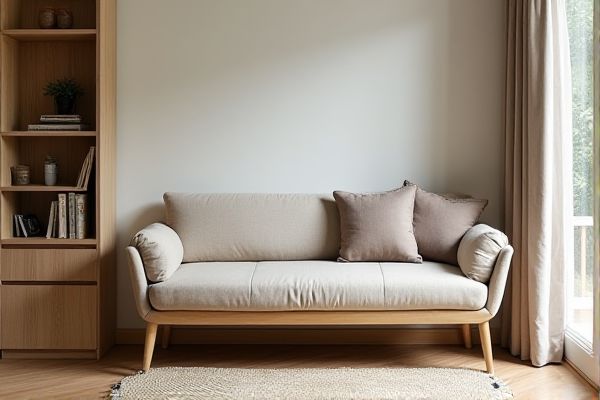
A settee offers cushioned seating with back support, making it ideal for comfort in living rooms, while a bench typically provides a firmer, backless surface suited for entryways or outdoor settings. Discover which option best fits Your space and style by reading the rest of the article.
Table of Comparison
| Feature | Settee | Bench |
|---|---|---|
| Definition | Upholstered seating furniture for multiple people, often with a back and arms | Long seat for multiple people, usually without back or arms |
| Design | Comfort-focused, cushioned, decorative | Simple, functional, often wooden or metal |
| Typical Use | Living rooms, parlors, formal seating areas | Outdoor spaces, dining areas, entryways, public places |
| Seating Capacity | 2 to 3 people | 2 to 4 or more people |
| Back Support | Yes, often with arms | No or minimal |
| Material | Wood frame with fabric or leather upholstery | Wood, metal, plastic; rarely upholstered |
| Comfort | High due to cushioning | Moderate to low |
| Price Range | Medium to high | Low to medium |
Understanding the Basics: What is a Settee?
A settee is a type of upholstered seating furniture designed for two or more people, often featuring a backrest and armrests for added comfort. Unlike a bench, which is typically hard-surfaced and can accommodate multiple users without individual seating contours, a settee provides a more cushioned and cozy experience. Understanding your seating needs helps determine whether a settee's padded design or a bench's versatility better suits your space.
Defining a Bench: Features and Functions
A bench is a long, sturdy seating furniture typically designed for multiple users, often made from wood, metal, or plastic, and found in both indoor and outdoor settings. It usually lacks a backrest and armrests, emphasizing space efficiency and versatility for various activities such as dining, waiting, or storage seating. Commonly used in parks, hallways, and entryways, benches prioritize durability and functionality over comfort compared to settees.
Key Differences Between Settees and Benches
Settees typically feature upholstered seats and backrests, providing enhanced comfort and style compared to benches, which usually have a simple, hard surface designed for more utilitarian seating. Benches often offer greater versatility in size and placement, suitable for both indoor and outdoor use, while settees are traditionally used indoors as elegant seating options in living rooms or entryways. Your choice depends on whether you prioritize comfort and aesthetic appeal or practical and flexible seating arrangements.
Materials Used in Settees vs Benches
Settees are commonly upholstered with materials such as leather, velvet, or linen, providing a cushioned and comfortable seating experience ideal for indoor use. Benches typically feature durable materials like wood, metal, or plastic, designed for practicality and often left unpadded or with minimal cushioning. The choice of materials in settees emphasizes style and comfort, while benches prioritize sturdiness and functionality across various environments.
Comfort Level: Seating Experience Compared
Settees provide superior comfort compared to benches due to their cushioned seats, supportive backrests, and often upholstered designs that enhance prolonged seating experiences. Benches typically feature hard, flat surfaces with minimal or no padding, making them less comfortable for extended use but practical for short-term seating in communal or outdoor settings. The ergonomic design of settees targets relaxation, while benches prioritize durability and space efficiency.
Style and Design Options
Settees offer a wide range of style and design options, featuring upholstered seats with backs and arms that provide a classic, elegant look suitable for living rooms or formal settings. Benches prioritize versatility and simplicity, often showcasing minimalistic or rustic designs with open seating, making them ideal for entryways, dining areas, or outdoor spaces. Both furniture pieces can be customized with various materials, colors, and finishes to complement different interior design themes.
Ideal Placement: Where to Use Each
Settees are ideal for living rooms, entryways, or bedrooms where comfort and style are prioritized, providing a cozy seating option that complements home decor. Benches suit outdoor patios, dining areas, or hallways, offering practical, space-saving seating that can double as storage or display surfaces. Your choice depends on whether you need a decorative, cushioned seat or a versatile, sturdy spot for quick sitting or multi-use functionality.
Pros and Cons of Settees
Settees offer cushioned seating and backrests, providing enhanced comfort compared to benches, making them ideal for living rooms and lounges. However, settees tend to be bulkier and more expensive, requiring more space and maintenance, which may not suit smaller areas or budgets. Your choice depends on whether you prioritize comfort and style or space efficiency and affordability.
Pros and Cons of Benches
Benches provide versatile seating options ideal for both indoor and outdoor use, often accommodating multiple people and saving space with their streamlined design. Their open structure and simpler construction make benches typically more affordable and easier to move than settees, though they may lack the cushioning and back support that enhance comfort in settees. While benches contribute to a minimalist aesthetic and facilitate easy cleaning, they can be less comfortable for prolonged sitting and offer limited ergonomic support compared to upholstered settees.
Choosing the Right Seating for Your Space
When choosing the right seating for your space, consider a settee for its upholstered comfort and stylish design ideal for living rooms or entryways. A bench offers versatile, space-saving seating with a minimalistic look perfect for dining areas, hallways, or outdoor settings. Matching your space's size and functionality ensures your furniture enhances both comfort and aesthetic appeal.
 homyna.com
homyna.com